Heading south from Turtle Beach during our Florida vacation, we were ready to see the wealth of plant and animal life that Southern Florida’s ecosystems are known for. Of course, that means lots of birds and alligators and then some, but also turtles, lizards, air plants, insects, mangroves, mammals, and more.
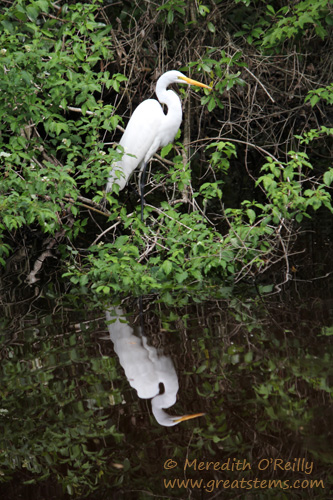 North of the Everglades is Big Cypress National Preserve, 729,000 acres that include a variety of habitat types — swamps, hardwood hammocks, pinelands, mangrove forests, prairies, and marsh. Considered a buffer between development and the fragile Everglades, it is also an important watershed for the Everglades. The preserve is filled with some of the most diverse tropical and temperate flora and fauna found anywhere in North America. Unfortunately, being a preserve doesn’t fully protect it — off-road vehicles, hunting, trapping, and even oil drilling can be found in places within the preserve — but overall it is a beautiful and valuable wildlife haven that is home to countless animal species, including the endangered Florida Panther and the threatened American Black Bear.
North of the Everglades is Big Cypress National Preserve, 729,000 acres that include a variety of habitat types — swamps, hardwood hammocks, pinelands, mangrove forests, prairies, and marsh. Considered a buffer between development and the fragile Everglades, it is also an important watershed for the Everglades. The preserve is filled with some of the most diverse tropical and temperate flora and fauna found anywhere in North America. Unfortunately, being a preserve doesn’t fully protect it — off-road vehicles, hunting, trapping, and even oil drilling can be found in places within the preserve — but overall it is a beautiful and valuable wildlife haven that is home to countless animal species, including the endangered Florida Panther and the threatened American Black Bear.
Adjacent to Big Cypress is Fakatchee Strand State Preserve, which has a wonderful 0.6-mile-long boardwalk that takes you through characteristic habitat found throughout Big Cypress. It is the largest Bald Cypress/Royal Palm swamp forest in the world. The experience led to a new ongoing family joke — the boys and I periodically declare one another a “Royal Palm in the neck.”
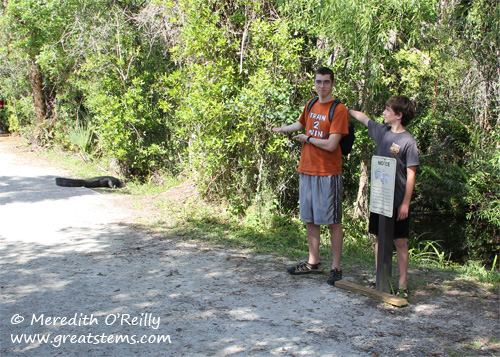 Walking toward the boardwalk, we encountered the first of many wildlife sightings along the trail.
Walking toward the boardwalk, we encountered the first of many wildlife sightings along the trail.
Here the boys stand by an “alligators are present and potentially dangerous” sign, near which sits an example subject of said sign.
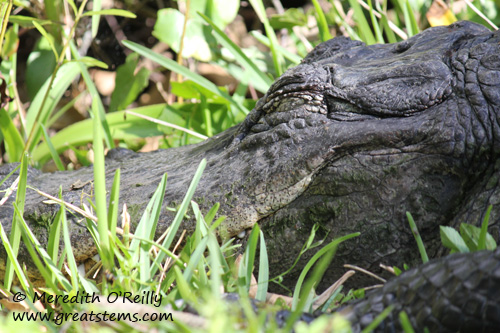 Since I was uncertain whether I’d have a chance for another great photo opportunity, I took a lot of photos of this American Alligator, especially because she was sleeping (until she was not… that story follows).
Since I was uncertain whether I’d have a chance for another great photo opportunity, I took a lot of photos of this American Alligator, especially because she was sleeping (until she was not… that story follows).
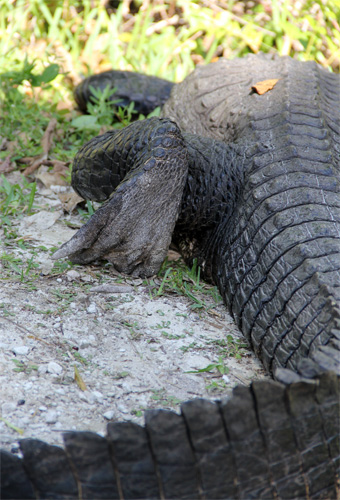
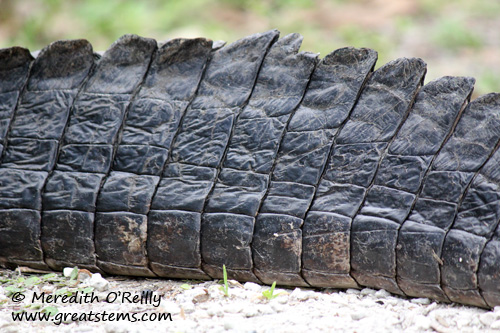 I’m utterly fascinated by crocodilian skin (alligators are part of the Crocodilia family). Of course, these images also bring to mind some of the longterm Floridian residents I saw at the beach. Their skin, damaged from decades of spending time in the sun, had wrinkles much like those you see here on this reptile. I find reptilian skin beautiful — wrinkled, sun-damaged human skin not so much.
I’m utterly fascinated by crocodilian skin (alligators are part of the Crocodilia family). Of course, these images also bring to mind some of the longterm Floridian residents I saw at the beach. Their skin, damaged from decades of spending time in the sun, had wrinkles much like those you see here on this reptile. I find reptilian skin beautiful — wrinkled, sun-damaged human skin not so much.
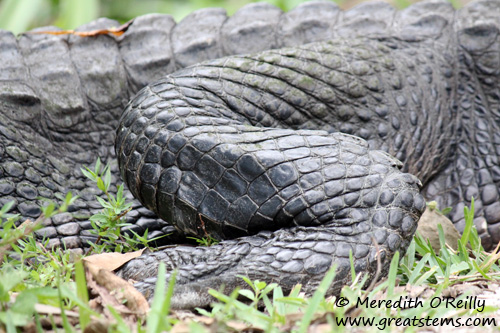
Don’t be tricked by their short legs — alligators are all muscle, and those short legs can provide fast bursts of speed.
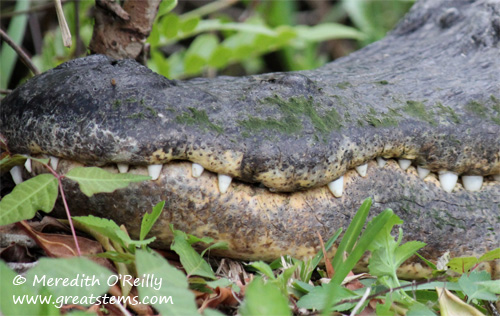 Those visible upper teeth are one way to tell an American Alligator from an American Crocodile. The latter have more of a zippered jaw look to their mouth.
Those visible upper teeth are one way to tell an American Alligator from an American Crocodile. The latter have more of a zippered jaw look to their mouth.
Everything about a crocodilian’s appearance says, “You are a fool if you mess with me.” And I didn’t mess with this alligator, being careful to stay many feet back and use a zoom lens. But I did crouch down to her level as I took pictures.
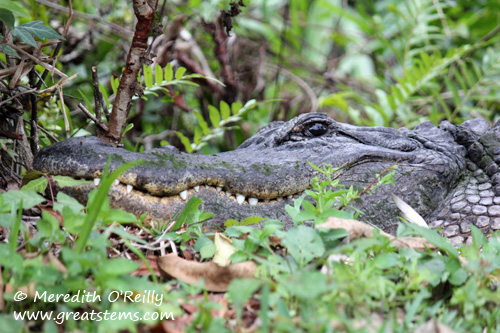
And eventually, Mama Alligator opened her eyes and noticed me. She watched me take pictures for a while. I know that she didn’t see me as a threat, but eventually she decided that she didn’t like me being crouched in her low-to-the-ground visual range, no matter how far away I was.
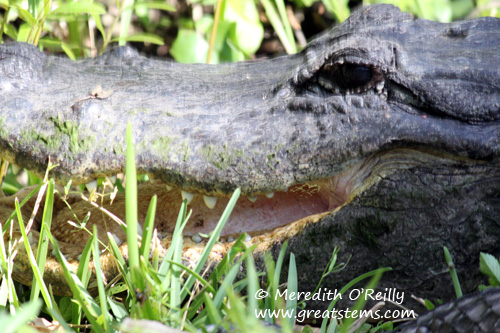
So she decided to let that be known, opening her mouth a little and staring me down as she turned her head toward me.
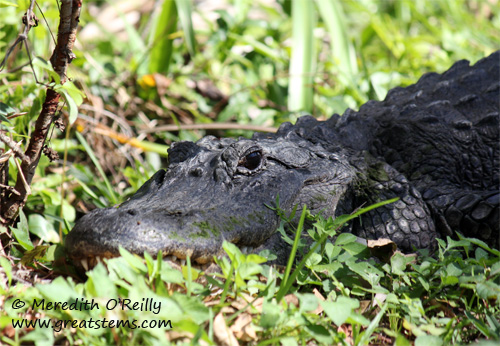
From that point on, she faced me to keep an eye on me, and the boys and I thanked her for her time and moved on down the trail.
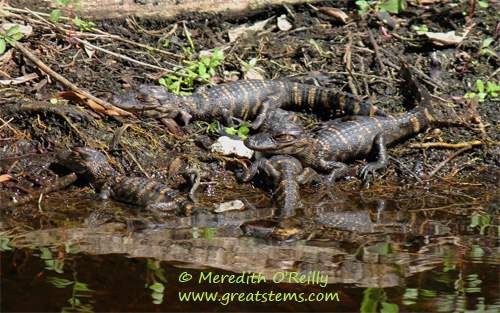 A little ways away was a little ‘gator pond of sorts. Across the pond were 6-month old alligators snoozing by the water’s edge. There were nine in all, apparently, but I could only see seven that day — the image shows four of them. I don’t know whether the big alligator on the trail was their Mama, but I called her that. Or maybe I called him that.
A little ways away was a little ‘gator pond of sorts. Across the pond were 6-month old alligators snoozing by the water’s edge. There were nine in all, apparently, but I could only see seven that day — the image shows four of them. I don’t know whether the big alligator on the trail was their Mama, but I called her that. Or maybe I called him that.
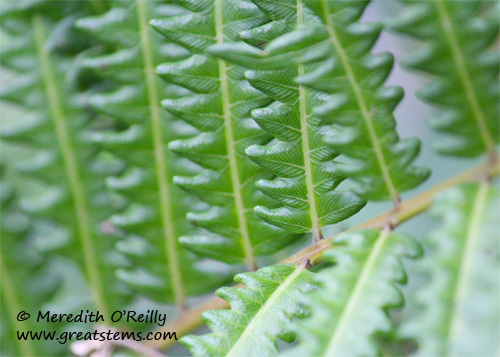 The boardwalk led us along swampier portions of the trail, with beautiful and unusual plant life, lots of ferns, and even a giant Bald Eagle nest that has been in yearly use since 1991.
The boardwalk led us along swampier portions of the trail, with beautiful and unusual plant life, lots of ferns, and even a giant Bald Eagle nest that has been in yearly use since 1991.
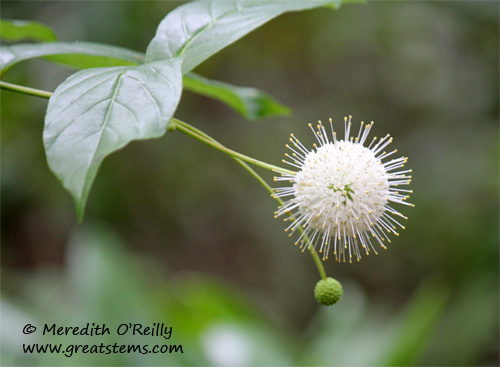
Button Bush
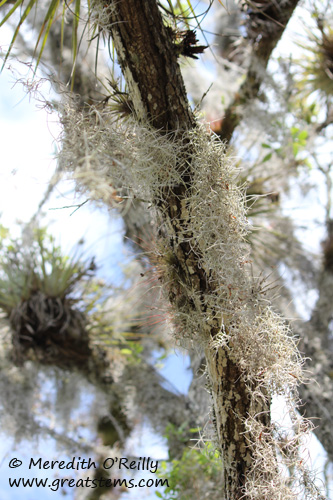
Tree after tree along the trail had companion plants called epiphytes — air plants. Spanish moss, ball moss, orchids, epiphytic Bromeliads — these are all types of plants that grow on trees, using them for support but taking their water and nutrients from the air, falling rain, and compost on the trees. They are not directly parasitic as other plants can be. We did, however, see some trees during our trip that had Spanish Moss so plentiful that it was shading out lower branches and as a result affecting the overall health of the trees.
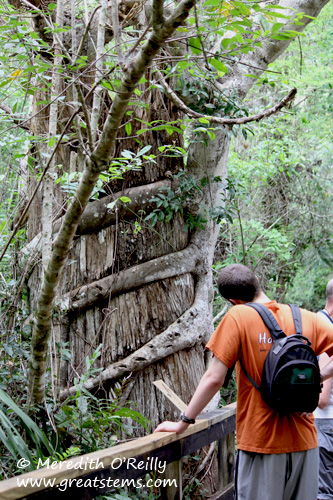 Another type of air plant that in time can cause the decline of a host tree is the Strangler Fig, and we saw examples of it along the Big Cypress path. Though it looks at first like a vine, it is actually a tree.
Another type of air plant that in time can cause the decline of a host tree is the Strangler Fig, and we saw examples of it along the Big Cypress path. Though it looks at first like a vine, it is actually a tree.
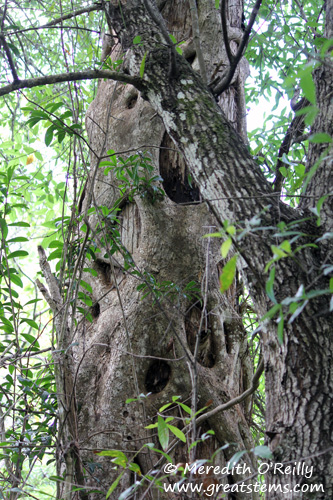
The Strangler Fig begins as an epiphyte in the canopy of the host tree, such as a Bald Cypress, and over time its roots grow downward and fuse together. The fused roots can become gigantic as they encircle the host tree, causing girdling and the eventual death of the host.
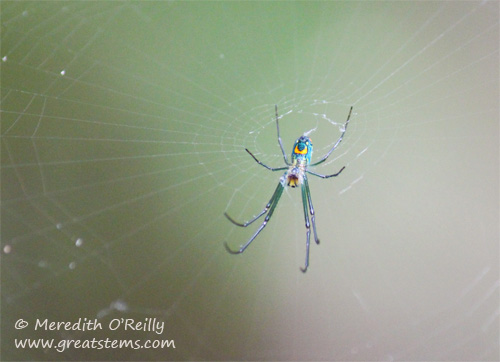
A common sight along the plants near the boardwalk were the webs of this tiny spider and its siblings and cousins, Florida Orchard Spiders.
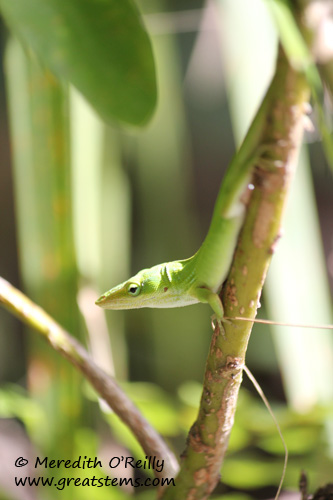
We felt pretty lucky to see the occasional Green Anole, a lizard native to Florida. Most of the time we saw Brown Anoles, native to Cuba and the Bahamas and considered invasive to Florida. They compete with the Green Anole for resources, and they sometimes eat the young Green Anoles, as well. A picture of Brown Anole is shown later in this post.
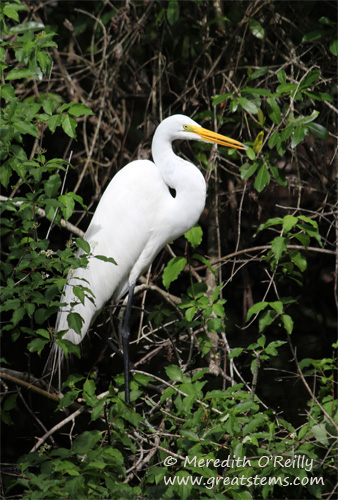
Here’s another look at the beautiful Great Egret, that was shown with its reflection in the water at the top of this blog entry.
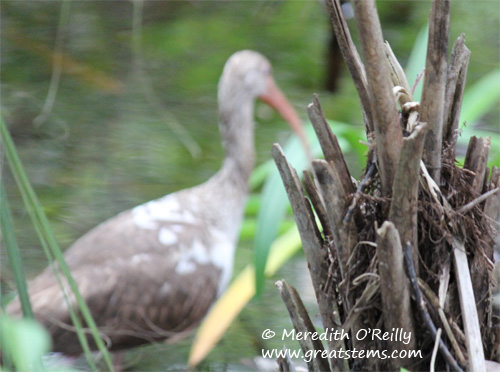
I know this isn’t a great picture, but I love the artistic appearance of the Ibis in the background.
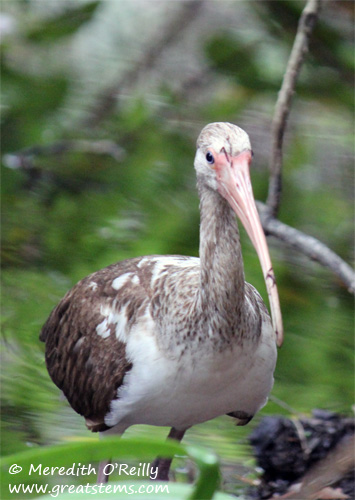 Specifically the bird is an immature White Ibis — in time almost all of its feathers will be completely white.
Specifically the bird is an immature White Ibis — in time almost all of its feathers will be completely white.
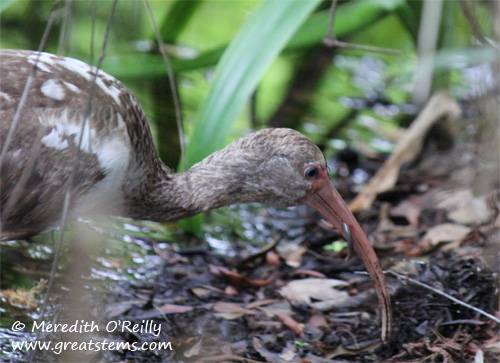
Its long curved bill is perfect for poking around in the soft wet earth. As you can see, earthworms are a tasty favorite, at least for the bird. Side note: the boys and I bought some Bertie Bott’s Every Flavor Beans (from Harry Potter) while we were in Florida. We now know from experience that earthworm-flavored candy is not a taste we’d like to encounter again.
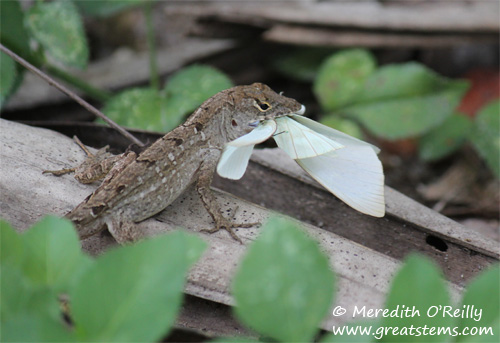
As we were leaving, the boys counted as many lizards as they could find. I think they were in the thirties when they spotted this Brown Anole with its recent butterly capture. I was so happy to finally have a picture of a lizard eating an insect — but did it have to be an invasive lizard?
If you are visiting Southern Florida, I highly recommend Big Cypress Bend Boardwalk. We continued our trip from there to Everglades, the next post in this series.
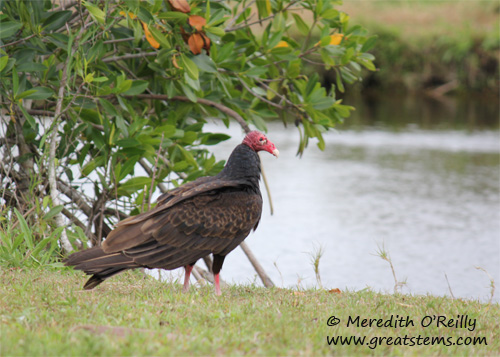 As we were leaving the area, we happened upon a group of turkey vultures, who started walking toward, almost stalking our car. We wondered about this and drove on to the Everglades, soon discovering that vulture encounters were about to be a rather common, bizarre experience….
As we were leaving the area, we happened upon a group of turkey vultures, who started walking toward, almost stalking our car. We wondered about this and drove on to the Everglades, soon discovering that vulture encounters were about to be a rather common, bizarre experience….
Oh man, suddenly I have a craving for trip to Florida…that looks like so much fun! I’m so jealous!
If you have extra time, the Naples area has tons of great wildlife spots to check out too…Corkscrew Swamp Sanctuary and Ding Darling NWR are my favorites. The beaches aren’t bad either!
What a fascinating journey…I am not sure I would be so brave as to be anywhere near that alligator…. beautiful wildlife!!
Ooh, I’ll have to look into those for our next visit, Julie. So much to do, so little time! We can’t wait to go back. Thanks for the tips!
Donna, the wildlife were so cooperative about posing — make a photographer’s job easy!
Beautiful shots — looks like an amazing trip for sure! I wonder if control efforts are in place (or being planned) to help minimize the impact of the brown anole? Off to check…
Wew That crocs is scary 😮 nice photos – Enah
Nice pictures – I’ll have to add this to my list of things to see/do in Florida when we finally go visit our friends (they live close to the Everglades, so I figured we’d see that and Hemingway’s house in Key West.
I don’t know that control efforts are even possible. That anole is very well-established across the entire state. We saw 30 browns for every 1 green, and on our entire trip, we saw a total of 2 green anoles. Sad.
Thanks, Enah. Scary, perhaps, but also cool!
My advice is to give yourself several days there! Also to avoid mosquito season!
What a wonderful, informative post. I’m glad the alligator didn’t move to hiss at you. That’s there next level of threat.
And in Houston, there is Armand Bayou Nature Center. That is the only place I’ve been accosted by begging black vultures. And it is a fabulous place to see all kinds of birds and alligators. I used to paddle there several times a year.
I absolutely love living in Florida, especially since my birthplace was up North. The warmth and beauty is amazing. The enjoy the wildlife at Turtle Beach and the Everglades. Great photos! I do agree the mosquito season is the worst…
Marilyn, I’ll be sure to check it out with the boys. That’s much closer than Florida!
Thanks, Anne — it sure was a wonderful trip.